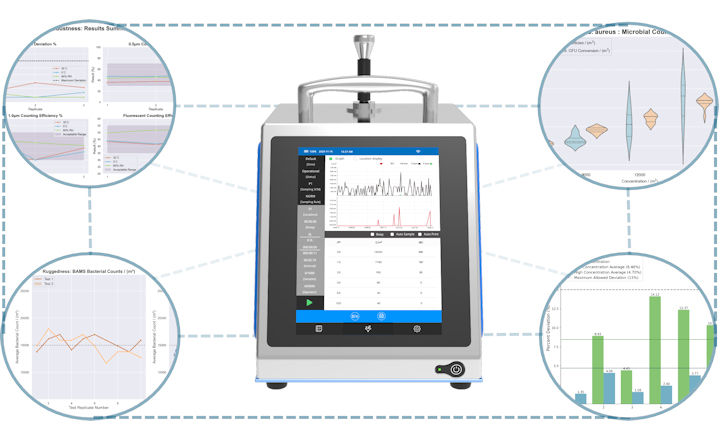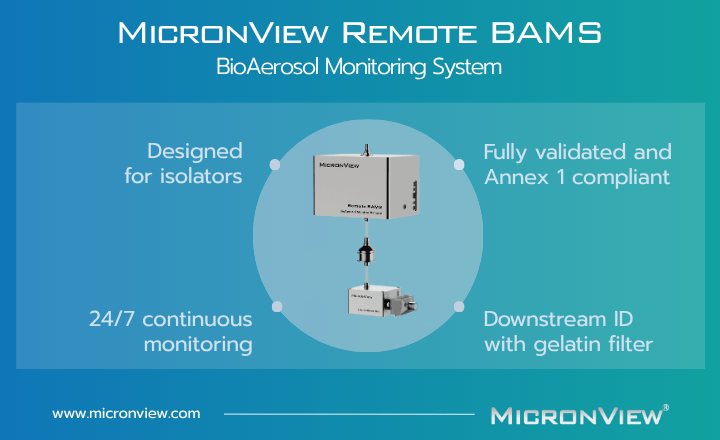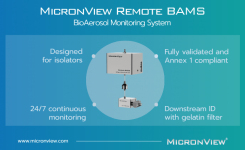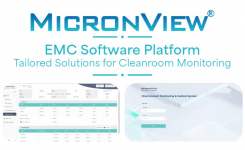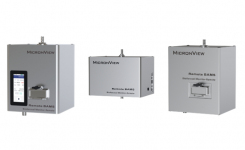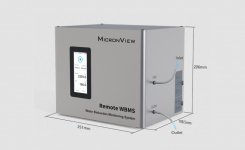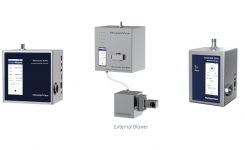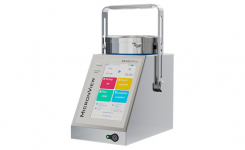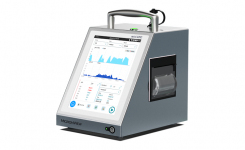Understanding USP <1223> Validation Testing
USP <1223> provides a thorough framework for validating alternative microbiological methods, ensuring that tools like the BAMS meet standards for testing quality. This validation process is critical for methods intended to complement or replace traditional culture-based monitoring, providing strong assurance that these new technologies can reliably detect and quantify airborne microorganisms in real time. The validation included accuracy, precision, specificity, sensitivity, linearity, range, ruggedness, robustness, and equivalency testing. The process involves comparing the new technology to a traditional growth-based method.
MicronView’s BAMS, a bio-fluorescent particle counter, recently completed the full range of USP <1223> validation tests. The results confirm that BAMS meets or exceeds the performance of conventional methods (in this case, the Andersen six-stage sample) for every criterion tested. Offering real-time data, the BAMS allows for more proactive monitoring of microbial contamination in cleanrooms and other controlled environments, enabling users to detect issues quickly and enhance contamination control.
BAMS USP <1223> Validation Highlights
- Accuracy
BAMS achieved a relative recovery rate at a minimum of 98% when compared to traditional growth-based sampling across five key microorganisms—Staphylococcus aureus, Escherichia coli, Micrococcus luteus, Bacillus subtilis, and Candida albicans—exceeding USP accuracy requirements. This strong performance ensures that BAMS’s real-time results are as good or better than the results from traditional culture methods. - Precision
Precision testing demonstrated BAMS’s ability to produce consistent results with impressively low relative standard deviation (RSD), significantly outperforming the traditional Andersen sampler. Across various microbial concentrations, BAMS achieved up to 60-300% higher precision, giving users confidence in its reproducibility and supporting rigorous quality standards. - Specificity and Range of Detection
Using laser-induced fluorescence technology, BAMS successfully detected a variety of microorganisms, including Gram-positive and Gram-negative bacteria, bacterial spores, yeast, and mold spores. This broad detection range ensures adaptability to diverse microbial profiles in cleanroom environments. Additionally, BAMS’s ability to distinguish biological particles from non-biological false-interferents minimizes false positives, enhancing monitoring reliability.
Additional USP <1223> Tests Completed
In addition to excelling in accuracy, precision, and specificity, BAMS passed all additional USP <1223> validation tests, further establishing its robustness and reliability for microbial monitoring. These additional tests included:
- Sensitivity: Verified BAMS’s low-level detection capabilities, with a Limit of Detection (LOD) of 4-5 CFU/m³ and a Limit of Quantification (LOQ) of 24-26 CFU/m³. This result is limited by the test system. In reality, the BAMS is capable of detecting a single microbial cell.
- Linearity: Confirmed the proportionality between BAMS measurements and microbial concentrations as determined by the Andersen.
- Range: Established the operational concentration range over which BAMS maintains validated performance.
- Ruggedness: Ensured that minor operational changes do not impact BAMS’s accuracy or precision.
- Robustness: Demonstrated consistent performance across varying environmental conditions, including temperature and humidity fluctuations.
Conclusion
MicronView’s BioAerosol Monitoring System (BAMS) has proven itself in all aspects of the USP <1223> validation testing, establishing it as a highly accurate, precise, and versatile solution for real-time environmental monitoring. Its robust performance and broad detection range in comparison with traditional growth-based methodology make BAMS an ideal choice for regulated environments. Facilities integrating BAMS can enhance contamination control while meeting regulatory demands efficiently.
If you would like an official report or more information about the BAMS USP <1223> results, use the Request Information button below to contact MicronView.


